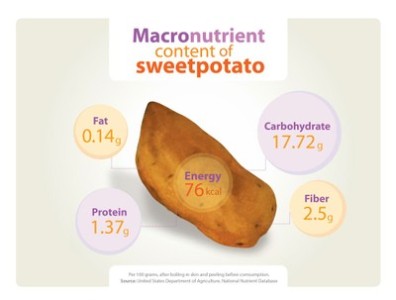Sweetpotato Nutrition
Sweetpotatoes produce more edible energy per hectare per day than wheat, rice or cassava. They are good sources of carbohydrates, fiber, and micronutrients. The leaves and shoots, which are also edible, are good sources of vitamins A, C, and B (Riboflavin).

Orange-fleshed sweetpotato is an important source of beta-carotene (the precursor to Vitamin A). Just 125 g of fresh roots from most orange-fleshed varieties contain enough beta-carotene to provide the daily pro-vitamin A needs of a preschooler. This is particularly important in Sub Saharan Africa
and Asia where vitamin A deficiency is a leading cause of blindness, disease and premature death among children under five and pregnant women. Nutritionists identify different levels of beta-carotene according to varying pigmentation in orange-fleshed varieties by means of a color chart.
CIP is exploring the potential cancer preventing properties of purple fleshed sweetpotato. The anthocyanins that account for the purple pigmentation in this variety are powerful antioxidants and have good bioavailability, meaning they are easily absorbed by the human body.
Average Micronutrient Content of Orange-Fleshed Sweetpotato
| Minerals | |
| Iron (mg) | 0.5 |
| Zinc (mg) | 0.2 |
| Calcium (mg) | 34 |
| Potassium (mg) | 298 |
| Phosophorous (mg) | 29 |
| Antioxidants | |
| Total carotenoids (mg) | 15.5 |
| Beta-carotene (mg) | 13.1 |
Per 100 grams of fresh-weight, raw, unpeeled sweetpotato
Source: Quality and Nutrition Lab, CIP
